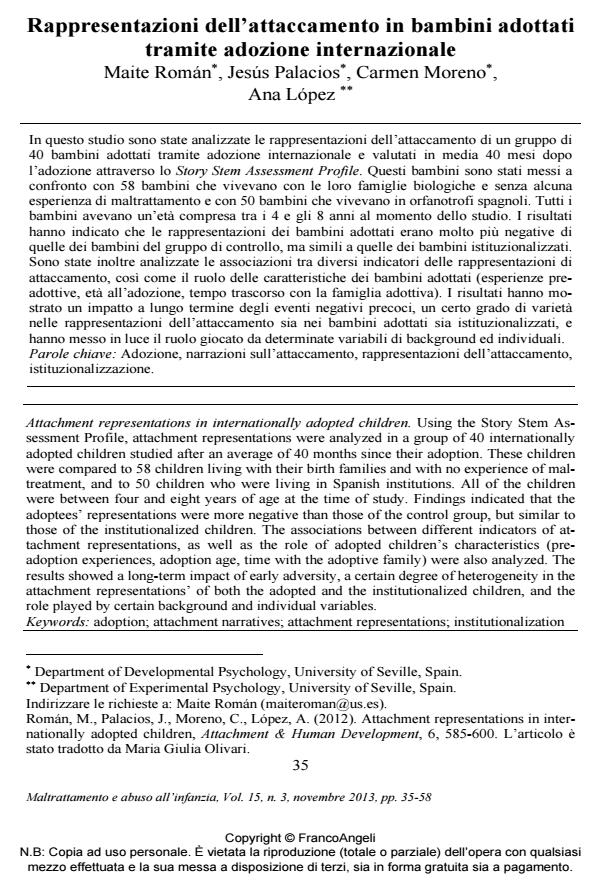Rappresentazioni dell’attaccamento in bambini adottati tramite adozione internazionale
Titolo Rivista MALTRATTAMENTO E ABUSO ALL’INFANZIA
Autori/Curatori Maite Romàn, Jesùs Palacios, Carmen Moreno, Ana Lòpez
Anno di pubblicazione 2013 Fascicolo 2013/3
Lingua Italiano Numero pagine 24 P. 35-58 Dimensione file 739 KB
DOI 10.3280/MAL2013-003003
Il DOI è il codice a barre della proprietà intellettuale: per saperne di più
clicca qui
Qui sotto puoi vedere in anteprima la prima pagina di questo articolo.
Se questo articolo ti interessa, lo puoi acquistare (e scaricare in formato pdf) seguendo le facili indicazioni per acquistare il download credit. Acquista Download Credits per scaricare questo Articolo in formato PDF

FrancoAngeli è membro della Publishers International Linking Association, Inc (PILA)associazione indipendente e non profit per facilitare (attraverso i servizi tecnologici implementati da CrossRef.org) l’accesso degli studiosi ai contenuti digitali nelle pubblicazioni professionali e scientifiche
In questo studio sono state analizzate le rappresentazioni dell’attaccamento di un gruppo di 40 bambini adottati tramite adozione internazionale e valutati in media 40 mesi dopo l’adozione attraverso lo Story Stem Assessment Profile. Questi bambini sono stati messi a confronto con 58 bambini che vivevano con le loro famiglie biologiche e senza alcuna esperienza di maltrattamento e con 50 bambini che vivevano in orfanotrofi spagnoli. Tutti i bambini avevano un’età compresa tra i 4 e gli 8 anni al momento dello studio. I risultati hanno indicato che le rappresentazioni dei bambini adottati erano molto più negative di quelle dei bambini del gruppo di controllo, ma simili a quelle dei bambini istituzionalizzati. Sono state inoltre analizzate le associazioni tra diversi indicatori delle rappresentazioni di attaccamento, così come il ruolo delle caratteristiche dei bambini adottati (esperienze preadottive, età all’adozione, tempo trascorso con la famiglia adottiva). I risultati hanno mostrato un impatto a lungo termine degli eventi negativi precoci, un certo grado di varietà nelle rappresentazioni dell’attaccamento sia nei bambini adottati sia istituzionalizzati, e hanno messo in luce il ruolo giocato da determinate variabili di background ed individuali.
Parole chiave:Adozione, narrazioni sull’attaccamento, rappresentazioni dell’attaccamento, istituzionalizzazione.
- Ricucire le emozioni nell'esperienza adottiva: considerazioni teorico-cliniche e utilizzo del genogramma Flavia Alaggio, Emanuela Polverari, in RIVISTA DI PSICOTERAPIA RELAZIONALE 55/2022 pp.52
DOI: 10.3280/PR2022-055004
Maite Romàn, Jesùs Palacios, Carmen Moreno, Ana Lòpez, Rappresentazioni dell’attaccamento in bambini adottati tramite adozione internazionale in "MALTRATTAMENTO E ABUSO ALL’INFANZIA" 3/2013, pp 35-58, DOI: 10.3280/MAL2013-003003